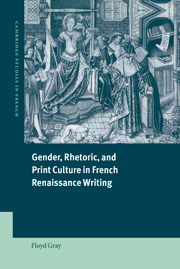Chapter 3 - Anonymity and the poetics of regendering
Published online by Cambridge University Press: 22 September 2009
Summary
It is already sufficiently difficult, as we have just seen, to distinguish between writer and rhetoric in self-consciously objective texts; it is almost impossible when the writer remains of necessity on the periphery of the written word, marginalized by ideological design, social status, civil or religious pressures. The fusion, even confusion, of writer and writing is a salient characteristic of early modern literature, prioritizing performance over person and rhetoric over self, especially in the transitional period between manuscript and print cultures as writers measure their professional responsibilities towards patrons and audience alike.
The advent of printing, and the possibility of increased circulation it afforded writers and their writing, tended to make recognition of authorship a priority in a system which depended almost exclusively upon patronage for its viability. Proprietary interest is reflected in the various efforts of Renaissance authors to spell out their own names and to create a place and a presence for themselves in their texts. This intention is evidenced first of all by the prominence afforded such paratextual matter as title page, privilège, author's portrait, and prologue; it is marked also, but more discreetly at first, by instances of self-promotion within the confines of the text itself, becoming much more blatant in Ronsard and the other Pléiade poets.
This chapter will be concerned first of all with the self-referential je in early Renaissance poetry written by men.
- Type
- Chapter
- Information
- Publisher: Cambridge University PressPrint publication year: 2000

